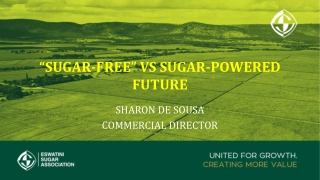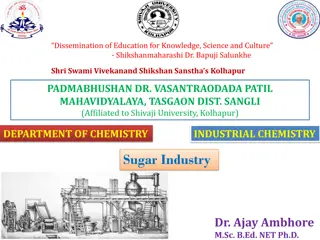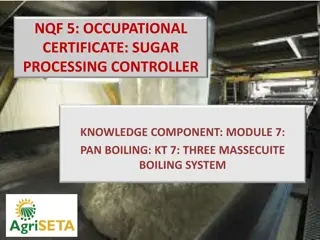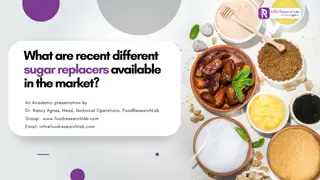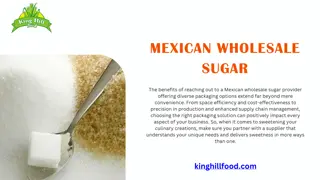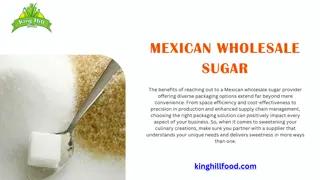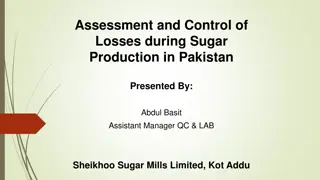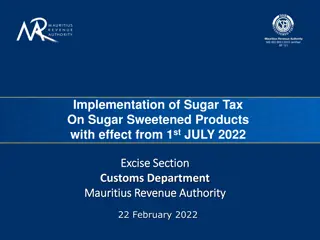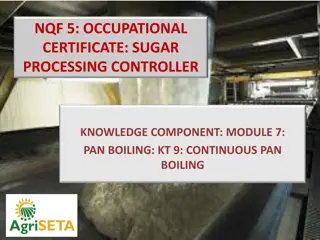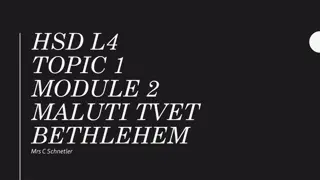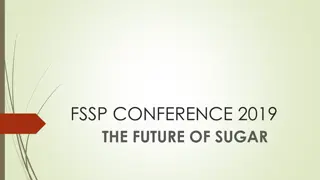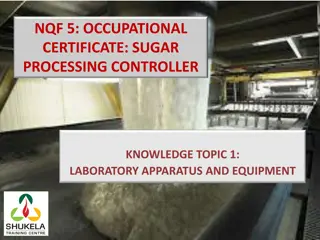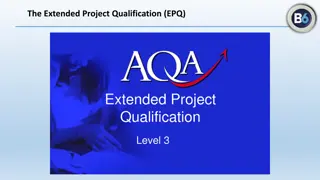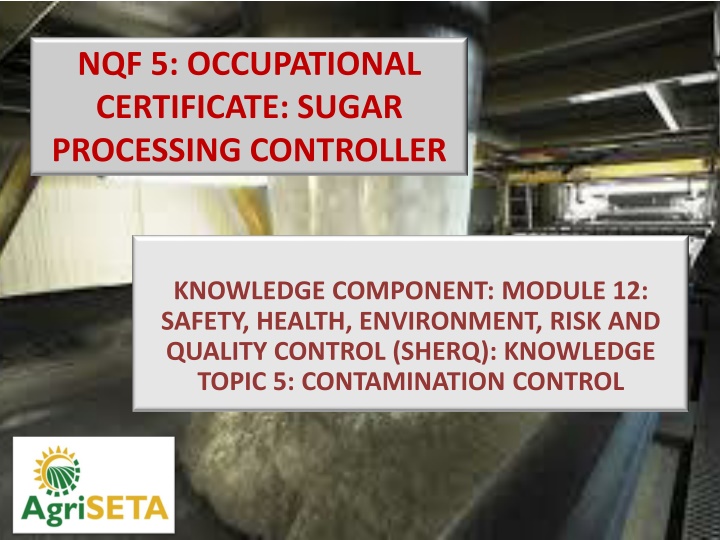
Effective Pest Control Strategies in Sugar Processing Factories
Learn about the importance of pest control in sugar processing factories to prevent contamination and ensure product safety. Discover methods such as risk assessment, exclusion measures, and proper documentation to maintain a pest-free environment.
Download Presentation

Please find below an Image/Link to download the presentation.
The content on the website is provided AS IS for your information and personal use only. It may not be sold, licensed, or shared on other websites without obtaining consent from the author. If you encounter any issues during the download, it is possible that the publisher has removed the file from their server.
You are allowed to download the files provided on this website for personal or commercial use, subject to the condition that they are used lawfully. All files are the property of their respective owners.
The content on the website is provided AS IS for your information and personal use only. It may not be sold, licensed, or shared on other websites without obtaining consent from the author.
E N D
Presentation Transcript
NQF 5: OCCUPATIONAL CERTIFICATE: SUGAR PROCESSING CONTROLLER KNOWLEDGE COMPONENT: MODULE 12: SAFETY, HEALTH, ENVIRONMENT, RISK AND QUALITY CONTROL (SHERQ): KNOWLEDGE TOPIC 5: CONTAMINATION CONTROL
Controlling Pests in the Factory Active measures should be taken to control and limit pest activity throughout all process, storage and handling areas. Risk assessment methods are used to identify potential problems with all classes of animals (e.g. birds, insects, reptiles and mammals) whether they are wild, feral or domestic. Records are maintained to show that risks from pests are adequately managed and consistently under control. Animals should, wherever possible, be excluded from the grounds of sugar milling establishments and the area surrounding stores.
Controlling Pests in the Factory (cont.) Where the presence of pests is unavoidable, procedures are implemented to protect the product from potential contamination. Wherever there is a significant risk from pests, access points are proofed against their entry. Doors are to be kept closed whenever possible and be close-fitting and proofed against pests when closed. Buildings should be kept in good repair and condition, to prevent pest access and to eliminate potential breeding sites. Holes, drains and other places where pests are likely to gain access should be kept sealed wherever possible. Where sealing is not possible, measures such as wire mesh screens should be used to reduce the possibility of pest entry. Pest infestations should be dealt with promptly and any actions taken should be compatible with the hygiene and quality requirements of the product. Only appropriately qualified/trained personnel should carry out any control treatment required.
Controlling Pests in the Factory (cont.) In cases where shooting is undertaken as part of the pest control programme, lead, or other toxic ammunition, should not be used. All bait containers should be fixed in their intended position unless there is a specific reason why this is not appropriate. Open bait containers and loose baits should not be positioned in areas where their use may result in a hazard to the sugar products. Pest control procedures must be documented and no materials designed to kill or deter pests must be allowed to contaminate the product. Pest control records include: Details of any poisons used, including safety data sheets; Qualifications of personnel involved in pest control activities; Map(s) indicating the location of any bait stations and with what they are baited; Records of any pests found; Details of corrective actions implemented.
Rodents Trapping of rodents has become the method of choice because traps do not employ the use of toxic materials, provide quick results and allow the removal of the rodents for proper disposal to avoid odours and insect issues associated with dead rodents. Rodents are responsible for 90% of the complaints against food companies and 90% of these complaints are due to mice. Rodents are nocturnal and thus seldom seen during the day, unless disturbed.
Rodents (cont.) Signs of rodent activity include: Rodent droppings Rodent tracks Rodent burrows Gnawing teeth marks Urine stains
Rodents (cont.) Adequate precautions must be kept in place to keep rats and mice out of the manufacturing environment. The entire factory environment should be such that rodents do not have hiding places. Ensure an active rodent and insect control program The reasons for such a program include: Producers must apply food safety principles when producing foodstuffs for human consumption as prescribed by law. Significant losses may occur due to consumption by rodents and/or contamination by rodents. When containing the population of rodents and insects (like flies) one indirectly reduces the risk for infections and sickness to humans.
Insects Insect infestation in a factory is a sign of poor cleaning practices and/or poor material inspection. There are three groups of insects that might infest a factory Crawling Cockroaches, ants etc. These insects are able to enter any small cracks and crevices. The best way of controlling access by crawling insects is to ensure all gaps are sealed. Flying Insects Flies, moths, bees etc. These insects are excluded from the mill by screens and strip curtaining. Any doors used to access the factory should have insect light traps (insectocute) units on the inside to attract any insects. Stored product insects Weevils. These are generally found in grain, but spread rapidly once they enter the mill. Good stock rotation are essential to avoid infestation.
Insects (cont.) Insects are controlled by: Removing nesting places (good stock rotation, cleaning practices and housekeeping). Removing food and water (good cleaning and storage practices). Keeping them out (good maintenance of structures and screening). Chemicals (licensed operators may use pesticides under controlled circumstances and no chemicals may be stored on-site with raw chemicals).
Birds Birds must not be allowed access to any part of the factory, including warehousing. The most effective way to control birds is to build them out and maintain the structures so that birds have no access points. The perimeter must be checked for signs of activity (droppings, nests) regularly and immediate action must be taken to remove the birds.
Contamination caused by Equipment or Facilities Contamination of the sugar product can occur: On the land During harvesting Post-harvest (during transportation) During processing During packaging During storage before sale.
Contamination caused by Equipment or Facilities (cont.) Types of contamination includes: Leuconostoc microorganisms Molds Yeasts Microorganisms Pieces of glass Sand Cigarette butts Pieces of fabric Pieces of wire.
Contamination caused by Equipment or Facilities (cont.) Product can be contaminated by four main sources: The people present in the workplace and their clothing. Other product that is already contaminated. Dirty work premises and equipment. Insects and vermin.
Contamination caused by Equipment or Facilities (cont.) The intention of food safety is to prevent food poisoning (the transmission of disease) and to maintain the quality of the product through all stages of processing, until it is finally eaten by humans. The presence of spoilage bacteria, taints or foreign material, may not necessarily cause food poisoning, but can still result in considerable loss if the product cannot be used. If the factory in which sugar is manufactured is clean, then the chances of contamination by foreign objects or diseases will be considerably reduced.
Contamination caused by Equipment or Facilities (cont.) Food hazards can be present, introduced, grown or survive (PIGS) at any point in the manufacturing process. There are three types of food safety hazards that can occur: P - Physical food safety hazards C - Chemical food safety hazards B - Biological food safety hazards
Physical Food Safety Hazards Dirt, hair, stones, soil, cigarettes or cigarette butts, nails, nuts and bolts, jewellery, match sticks, bone fragments, feathers, pieces of plastic or foil packaging material, stems, seeds, sticks and leaves, buttons, string and fibres or any other foreign substance.
Chemical Food Safety Hazards Chemical contaminants of sugar may include pesticides, medicines, detergents, disinfectants or any other chemical substance that could find its way into the food chain. Residue monitoring and evaluation programs identify ingredients containing harmful residues and remove them from the food chain. These residues include toxins from natural sources or from pesticides administered too soon before harvest.
Chemical Food Safety Hazards A number of agricultural chemicals (pesticides, herbicides, and fertilizers) may leave potentially hazardous residues in foods, and chemical contamination during manufacture is also possible. Where compounds that might enter the food chain are known or believed to be hazardous, there are limits on the maximum amount that may be present in foods. This acceptable daily intake is set by determining the highest lifetime level of intake that causes no detectable effect, and dividing it by a safety factor of 100.
Biological Food Safety Hazards Biological contamination can be caused by: bacteria, yeasts, protozoa, molds and viruses These come as a result of poor sanitation, poor quality management and poor hygiene practices. Bacteria and fungi are the principal types of micro-organisms that cause food spoilage and food-borne illnesses. Sugar cane may be contaminated by micro-organisms at any time during harvest, storage, processing, distribution, handling or preparation. The primary sources of microbial contamination are soil, air, humans, animals, plant surfaces, sewage, and food processing machinery or utensils.
Effects of Microbial Contamination Contaminating microorganisms use sucrose to sustain their metabolic processes, and in return produce gums, alcohols and/or organic acids. These products of microbial metabolism are then excreted into the surrounding environment (i.e. the sugarcane stalks and relevant processing streams). Two major actions of contaminating microorganisms are: The removal of sucrose from the sugar production process (by using it to grow and reproduce), directly resulting in reduced sucrose availability for sugar production Producing gums from the sucrose, resulting in a multitude of problems in sugarcane processing which include reduced pol analysis, clarification, evaporation and crystallisation rate of sucrose, factory capacity, scale formation, crystal shape, exhaustibility of massecuites, molasses purity and gelling of molasses. Gums can seriously reduce the efficiency of both raw sugar manufacturing and refining.
Preventative Actions for Microbial Contamination Clean harvested canes: Harvested cane should be free from mud and trash and should be loaded in a proper manner in the trucks so that no fractures or damage occurs to the sugarcane stalk which helps in preventing further invasion sites for microorganisms. No delay in clarification step after extraction: The clarification process should be immediately followed by the extraction step. In this process, addition of lime takes place that increases the pH of the juice to about 8.0 and rapid heating to 80-100 C for destruction of microorganisms. This step in sugar processing reduces the growth and proliferation of microorganisms by 99.99%. Although microorganisms are killed in this process, dextran and mesophilic or thermophilic spores are not killed.
Preventative Actions for Microbial Contamination (cont.) Maintenance of high temperatures in diffuser: In diffusion plants, during sugar processing maintaining high temperature is an efficient way for controlling microorganisms. Cleaning of the equipment and maintenance of hygiene: Sugar processing requires good hygiene for controlling microorganisms. Maintenance of this by adequate awareness for cleaning the equipment is required for avoiding the build-up of microorganisms like slime producers
Mycotoxins A mycotoxin is a toxic secondary metabolite produced by organisms of the fungus kingdom and is capable of causing disease and death in both humans and other animals. The term 'mycotoxin' is usually reserved for the toxic chemical products produced by fungi that readily colonize crops including sugar cane. Examples of mycotoxins causing human and animal illness include aflatoxin, citrinin, fumonisins, ochratoxin A, patulin, trichothecenes, zearalenone, and ergot alkaloids such as ergotamine.
Mycotoxins (cont.) Many factors are involved in enhancing the formation of mycotoxins. They are: Plant susceptibility to fungal infestation Suitability of fungal substrate Temperate / climate Moisture content Physical damage of plant due to insects and pests.
Mycotoxins (cont.) Toxin-producing fungi may invade at: pre-harvesting period, harvest-time, during post-harvest handling and in storage. The prevention of mycotoxins in our environment is a big task.
Mycotoxins (cont.) In general, prevention of the contamination of fungi and their mycotoxins in agricultural commodities can be divided into these following three levels. Primary prevention development of fungal resistant varieties of plants; control field infection by fungi of crop; making schedule for suitable pre-harvest, harvest and post-harvest; lowering moisture content of plant, after post harvesting and during transportation; Store product at low temperature whenever possible; Using fungicides and preservatives against fungal growth; Control insect infestation in stored product with approved insecticides.
Mycotoxins (cont.) Secondary prevention If the invasion of some fungi begins in the product at an early phase; this level of prevention will then be required. The existing toxigenic-fungi should be eliminated or its growth must be stopped to prevent further deterioration and mycotoxin contamination. Several measures are suggested as follows: Stop growth of infested fungi by re-drying the products; Removal of contaminated product; Inactivation or detoxification of mycotoxins contaminated; Protect stored products from any conditions which favour continuing fungal growth.
Mycotoxins (cont.) Tertiary prevention If the product is already heavily infested by toxic fungi, the primary and secondary preventions will not then be feasible. Any action would not be as effective as the practices mentioned above, since it will be quite late to completely stop toxic fungi and reduce their toxin formation. However, some measures should be done to prevent the transfer of fungi and their health hazardous toxins in highly contaminated product into the human food chain or the environment. Only a few practices are recommended: Complete destruction of the contaminated product; Detoxification or destruction of mycotoxins to the minimal level.

